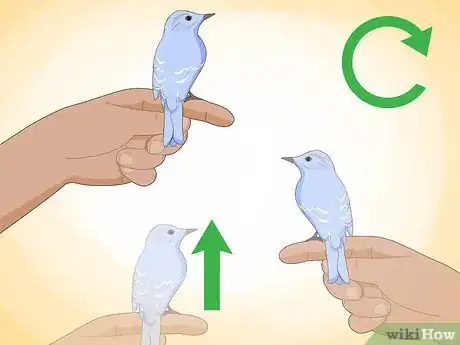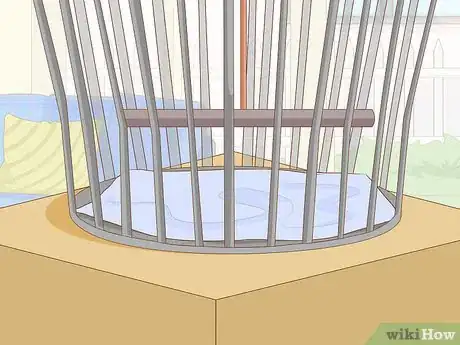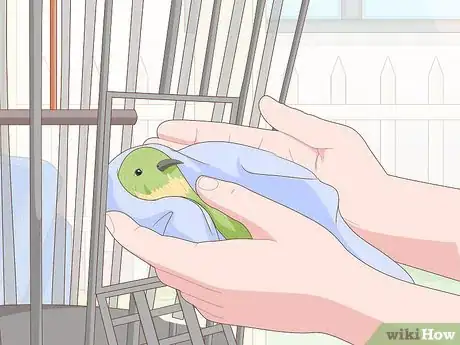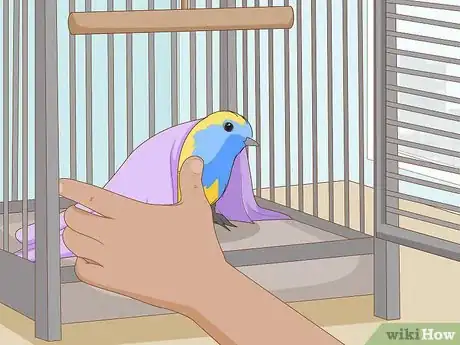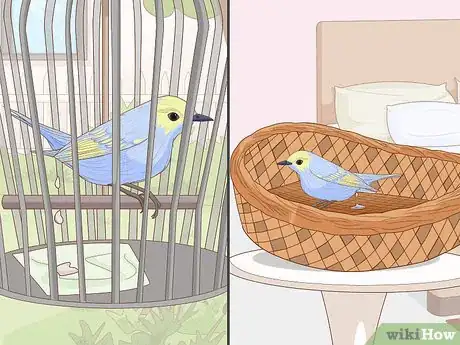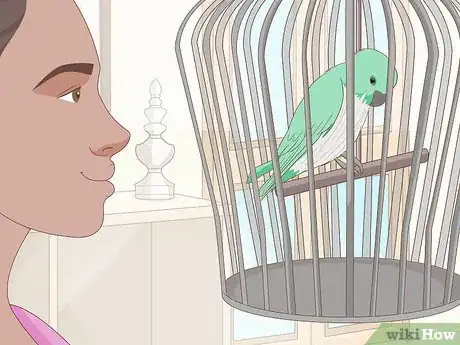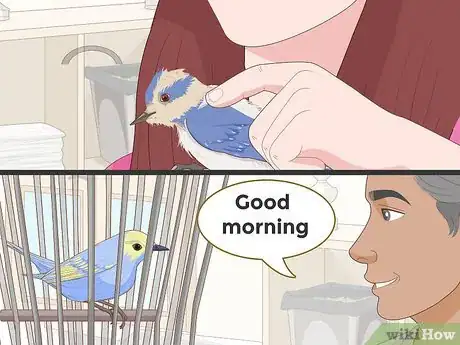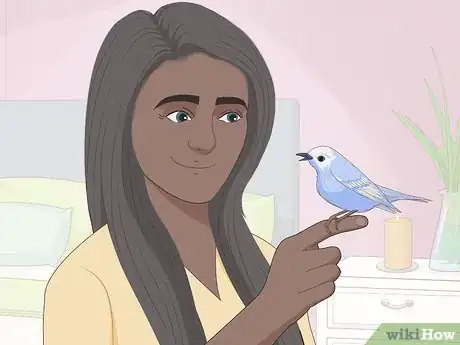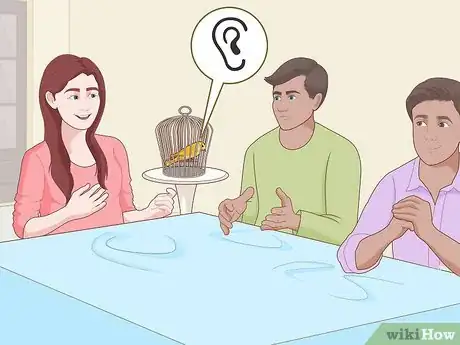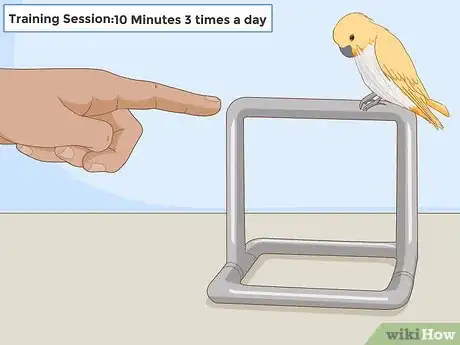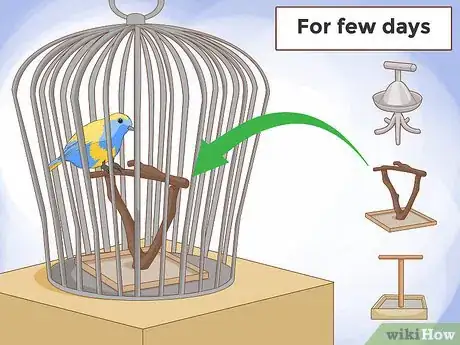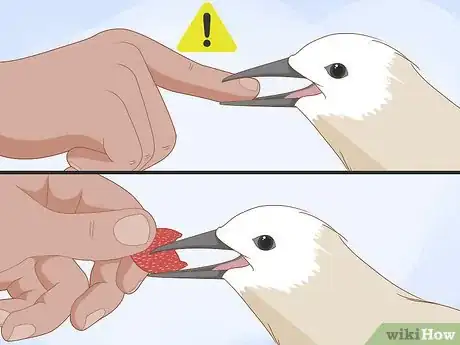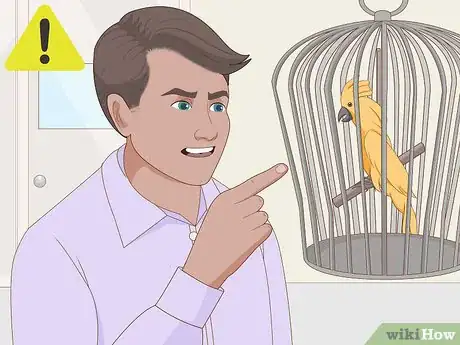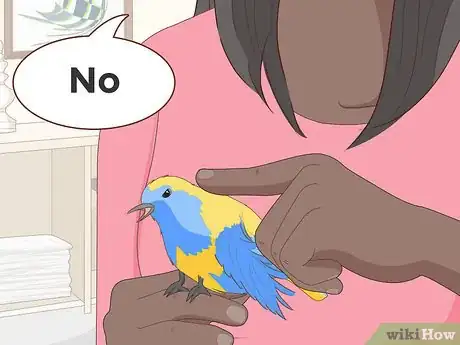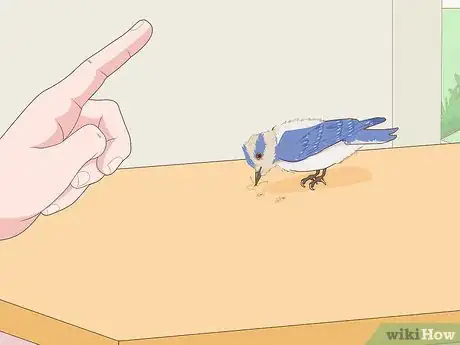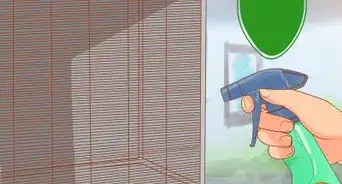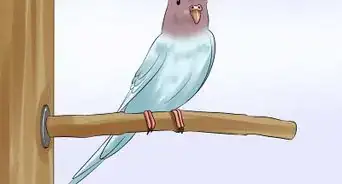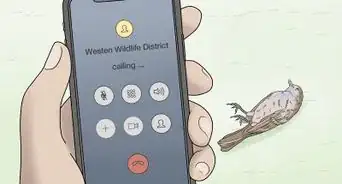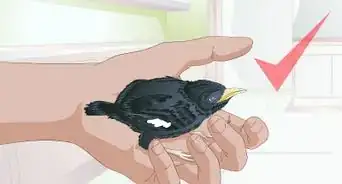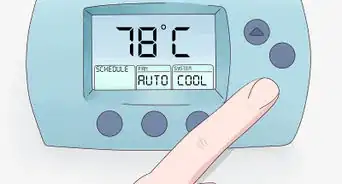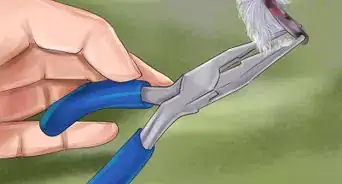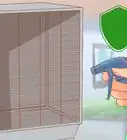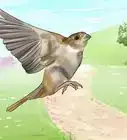This article was co-authored by Pippa Elliott, MRCVS. Dr. Elliott, BVMS, MRCVS is a veterinarian with over 30 years of experience in veterinary surgery and companion animal practice. She graduated from the University of Glasgow in 1987 with a degree in veterinary medicine and surgery. She has worked at the same animal clinic in her hometown for over 20 years.
There are 14 references cited in this article, which can be found at the bottom of the page.
This article has been viewed 68,490 times.
Birds are very clever animals,[1] and can make very fun and interesting pets. With patience and practice, you can train your bird to do different tricks, and even train him where to go to the bathroom! Training your bird is an excellent way to bond with him, so have fun and enjoy the process.
Steps
Training Your Bird to Step Up and Down
-
1Acclimate your bird to your hand. Training your bird to step up has many benefits, including decreasing his fear towards you, establishing your authority, and decreasing his territorial behavior.[2] Your bird may not be immediately comfortable with stepping up on your hand, so he will need to first get used to your hand. Begin by placing your hand near the outside of his cage for about a week, and talking to him in a gentle voice.[3]
- Once your bird is comfortable with the sight of your hand, place your hand in his cage in a slow and non-threatening manner. It may take another week before he is comfortable with your hand inside his cage.[4]
-
2Place a treat in your hand. Your bird may be comfortable with your hand inside his cage, but he still may not want to step on it. Entice him to come closer with a treat. Reward him with the treat when he steps closer, even if he does not actually touch your hand at first.[5]Advertisement
-
3Hold your index finger like a perch. Once your bird is at ease with your hand being inside his cage, position your index finger like a perch (finger pointed out). Slowly move your hand closer to your bird. Next, gently press your finger against your bird’s lower chest to encourage him to step up onto your finger.[8]
- Use a verbal cue (‘step up’ or ‘up’) as you press your finger against his chest.[9]
- Reward your bird immediately with verbal praise (‘good bird’) and a treat when he steps up onto your finger.[10]
- Your bird may not initially understand that he is supposed to step up onto your hand. If he runs away from your hand, entice him to your finger with some spray millet rather than following him around his cage with your hand.[11]
-
4Take your bird from his cage. Slowly take him out of his cage when he is perched on your finger. Be careful to avoid any toys or perches as you move your hand outside of his cage.[12]
- Do not be surprised if your bird suddenly panics and flies off your finger. If he does so, calmly walk to him and encourage him to step up again. Repeat this each time he flies off your finger.[13]
- If your bird seems distressed or exhausted, stop your training session and return him to his cage.[14]
- Hold your bird at your chest level when you have him outside of his cage. This will establish your authority over him.[15]
-
5Use your hands like a ladder. To add a challenge to this trick, encourage your bird to step up multiple times. Position your free hand above the hand on which he is perched. With the index finger of your free hand positioned like a perch, gently press against his chest and say your verbal cue.[16]
-
6Command your bird to step down. Slowly move your bird back into his cage with him still perched on your finger. Position him such that he will be facing forward in his cage. If you will be placing him on a perch, make sure that your finger is below the perch.[19]
- Use a verbal cue (‘step down’ or ‘down’) as he steps down, even though he will be stepping up onto his perch.[20]
- Reward your bird when he steps off your finger.
Training Your Bird With a Towel
-
1Use a white or light-colored towel. Towel training your bird is useful if you need to groom him, administer medication, or handle him when he is injured. Bright-colored towels may be alarming to your bird, so lighter-colored towels are preferable.[21]
- Place the towel on the bottom of his cage.
- It may be helpful to first leave the towel in your bird’s cage for several days to allow him to get used to its presence.
-
2Encourage your bird to step onto the towel. Similar to your hand, your bird may not be immediately comfortable with the towel. Place a treat on the towel to entice your bird to step on it.[22]
-
3Wrap your bird in the towel. When your bird is standing on the towel, gently wrap him up in it from behind. It is very important that you wrap him up in such a way that he cannot bite you, but is still able to breathe comfortably. To begin, gently place your thumb and middle finger of the hand holding the towel on each side of his neck.[23]
- Do not put any pressure on your bird’s neck with the thumb and middle finger.[24]
- Place the index finger of the hand holding the towel on top his head to keep him still.[25]
- Wrap your bird's wings inside the towel to prevent him from struggling and flapping his wings.[26]
- Make sure that the towel is not rubbing your bird’s eyes.[27]
- Do not put any pressure on his chest. Pressure on his chest could cause him to suffocate.[28]
- Try to rest your bird in the palm of the hand holding the towel.[29] You may need to use both hands if you have a larger bird.
-
4Unwrap your bird. Ensure that your bird’s feet are touching the bottom of his cage. With him stabilized on a solid surface, gently release your fingers from the sides of his neck and release him from the towel. He will probably ruffle his feathers and might even vocalize when you release him.[30]
- Allow your bird to relax and get comfortable again.[31]
- Reward him with a treat if he was still and did not try to bite you when you held him in a towel.
House Training Your Bird
-
1Choose a command. You may not have realized it, but you can house train a bird! Other than the benefit of cleaning up fewer messes, house training your bird will enhance your bond with him and allow you to have a better understanding of his body language. The command you choose should be short, such as ‘go potty’ or ‘go poop.’[32]
- Each person in your household should use the same command.[33]
-
2Select where you want your bird to defecate. Your bird’s cage probably seems like an obvious place for your bird to defecate. However, if you have him outside of his cage often, you may want to choose another object, such as newspaper or a wastebasket, where he can relieve himself.[34]
- Whichever location/object you choose, use it consistently as you are house training your bird.
-
3Observe your bird’s body language. Your bird will let you know when he has to go to the bathroom. For example, he may crouch his body. He may also move his tail, fluff his feathers, or step backward.[35]
- Being able to recognize this body language will let you be one step ahead of him and give him the command before he defecates.[36]
- It would also be helpful to make a note of when he usually goes to the bathroom. Most birds will defecate first thing in the morning, after meals, and when they are taken out of and placed back into their cages.[37]
- Smaller birds tend to go the bathroom more frequently than larger birds.[38]
-
4Move your bird to the ‘bathroom’ location. As soon as you see your bird making motions to relieve himself, command him to step up on your finger and move him to the area where he should defecate. Give him the verbal command and reward him immediately after he relieves himself.[39]
- Practice this each time your bird needs to defecate so that he forms the association between defecating in the right location and being rewarded for it.[40]
- Do not punish him if he defecates in the wrong location. Doing this may backfire—he might defecate in the wrong place just to get your attention.[41]
Teaching Your Bird to Talk
-
1Show your bird you love him. Teaching your bird to talk enhances your ability to communicate with him and vice versa. Before encouraging him to speak, though, it is important to communicate your love to him. Scratching your bird behind his neck while saying ‘I love you’ will let him know you love him.[42]
-
2Say a word with its corresponding action. It will be easier for your bird to learn words if he is able to link the words with a specific action. For example, say ‘scratch’ when you scratch your bird’s neck. You can also say ‘good morning’ and ‘good night’ as you respectively greet him in the morning and go to bed at night.[45]
- When you feed him, say the name of the food as you are giving it to him.[46]
- In time, you may notice your bird responding to your words with his body language (e.g., lifting his wing when you say ‘scratch’).
-
3Listen to your bird. Initially, your bird’s words will probably not sound very clear. He may make a mumbling or whispering noise. Even if you cannot make out the words, eagerly encourage him and repeat the words back to him to get him excited about saying them.[47]
- Reward him with verbal praise and a treat when he attempts to say the words you are teaching him.[48]
-
4Monitor how you speak around your bird. Birds are more likely to learn words that are spoken enthusiastically. If there is a word or phrase that you don’t want your bird to repeat, do not say it in an enthusiastic voice around him—he will probably pick up on it and repeat it when it is socially inappropriate for him to do so.[49]
- The words you want your bird to learn should be the only ones spoken in an enthusiastic voice when you are around him.
-
5Respond to your bird as he speaks to you. Your bird may forget the words or phrases you teach him if you do not react to him when he says them. He may also forget them if you do not continue to say them to him.[50]
Learning General Bird-Training Tips
-
1Get your bird to be comfortable with you. This can be particularly important for older or re-homed birds who have previously been mistreated or improperly trained. Doing quiet activities around your bird, such as reading or watching TV, will allow him to get comfortable with your presence without having to interact with you.[53]
- It may take your bird several weeks before he is comfortable with you. If that is the case, be patient with him and move at his pace.
- Quietly talking to him can also help your bird feel more at ease with you.
-
2
-
3Keep the training sessions short. As with other pets, long training sessions can lead to exhaustion or even boredom in birds. Training sessions with your bird should last for 10 minutes, two to three times a day.[58]
- Your bird may also become aggressive during his training sessions. He may show his aggression by vocalizing, flapping his wings, or biting you.[59] End the training session if he is displaying aggressive behavior.
- You should always end the training session on a good note, such as giving your bird verbal praise or a treat.[60]
-
4Acclimate your bird to your training props. Depending on which command you are teaching him, you may need props during the training session. Allowing your bird to become comfortable with the props first should make the training sessions go more smoothly. Placing the props in his cage for a few days will help your bird acclimate to them.[61]
- Playing with the props yourself may pique your bird’s interest in them.[62]
-
5Give your bird treats. Positive reinforcement is very helpful when training a bird. Treats are a great way to reinforce your bird’s positive behavior. To keep from being bitten, hold your fingers to the side of the treat when you give it to him.[63]
-
6Be consistent when using commands. Using the same command each time you are teaching your bird a new trick will help him learn the trick more easily.[67] If there are multiple members of your household, it is important for each person to use the same command for the same trick.
-
7Be patient. Your bird may take a long time to learn certain tricks. If this is the case, be patient with him as he learns. Be mindful, though, that your bird may take a long time to learn a trick because he does not want to learn it at all.[68]
- If your bird is getting frustrated or starts acting aggressively, it may be time to consider teaching him another trick.
-
8Do not punish your bird. Punishment is not effective for birds. In fact, the punishment may seem like attention to your bird, and he will continue to demonstrate the bad behavior.[69] Positive reinforcement, such as verbal praise or treats, is much more effective at training your bird than punishment.
-
9Discourage biting and screaming behavior. Biting and screaming are two undesirable behaviors that your bird may demonstrate. If your bird bites you, gently blow a puff of air in his face and firmly say ‘no.’ Do not give your bird a timeout if he bites you—he may learn that biting you is a way to get you to leave him alone.[70]
-
10Discourage biting and chewing on furniture. Bitter apple spray is an effective way of deterring your bird from inappropriate biting or chewing. Spray it wherever you notice these undesirable behaviors.[73] He will eventually learn the places where he should not bite or chew.
- Bitter apple spray is available at your local pet store.
Expert Q&A
-
QuestionHow do you tame a parrot?
 Melissa Nelson, DVM, PhDDr. Nelson is a Veterinarian who specializes in Companion and Large Animal Medicine in Minnesota, where she has over 18 years of experience as a veterinarian in a rural clinic. She received her Doctor of Veterinary Medicine from the University of Minnesota in 1998.
Melissa Nelson, DVM, PhDDr. Nelson is a Veterinarian who specializes in Companion and Large Animal Medicine in Minnesota, where she has over 18 years of experience as a veterinarian in a rural clinic. She received her Doctor of Veterinary Medicine from the University of Minnesota in 1998.
Veterinarian It's best to start with a very young bird and frequent (daily is recommended) gentle handling.
It's best to start with a very young bird and frequent (daily is recommended) gentle handling. -
QuestionHow do you teach a bird to talk?
 Melissa Nelson, DVM, PhDDr. Nelson is a Veterinarian who specializes in Companion and Large Animal Medicine in Minnesota, where she has over 18 years of experience as a veterinarian in a rural clinic. She received her Doctor of Veterinary Medicine from the University of Minnesota in 1998.
Melissa Nelson, DVM, PhDDr. Nelson is a Veterinarian who specializes in Companion and Large Animal Medicine in Minnesota, where she has over 18 years of experience as a veterinarian in a rural clinic. She received her Doctor of Veterinary Medicine from the University of Minnesota in 1998.
Veterinarian Firstly, it has to be a breed known to talk, and then secondly, it takes a lot of repetition/talking to the bird with simple single words.
Firstly, it has to be a breed known to talk, and then secondly, it takes a lot of repetition/talking to the bird with simple single words. -
QuestionCan a bird be potty trained?
 Melissa Nelson, DVM, PhDDr. Nelson is a Veterinarian who specializes in Companion and Large Animal Medicine in Minnesota, where she has over 18 years of experience as a veterinarian in a rural clinic. She received her Doctor of Veterinary Medicine from the University of Minnesota in 1998.
Melissa Nelson, DVM, PhDDr. Nelson is a Veterinarian who specializes in Companion and Large Animal Medicine in Minnesota, where she has over 18 years of experience as a veterinarian in a rural clinic. She received her Doctor of Veterinary Medicine from the University of Minnesota in 1998.
Veterinarian No, it is not really possible to potty train your bird. However, there are other ways to train your bird.
No, it is not really possible to potty train your bird. However, there are other ways to train your bird.
Warnings
- If you have a large parrot, do not allow him to sit on your shoulder. Being so close to your face in that position, he could easily bite a part of your face if he gets spooked.[79]⧼thumbs_response⧽
References
- ↑ http://www.petmd.com/bird/training/evr_bd_training_baby_birds?page=show
- ↑ http://www.peteducation.com/article.cfm?c=15+1795&aid=2580
- ↑ http://budgieplace.com/taming.html
- ↑ http://budgieplace.com/taming.html
- ↑ http://www.peteducation.com/article.cfm?c=15+1795&aid=2580
- ↑ http://budgieplace.com/taming.html
- ↑ http://budgieplace.com/taming.html
- ↑ http://www.petmd.com/bird/training/evr_bd_training_baby_birds?page=show
- ↑ http://www.petmd.com/bird/training/evr_bd_training_baby_birds?page=show
- ↑ http://www.petmd.com/bird/training/evr_bd_training_baby_birds?page=show
- ↑ http://budgieplace.com/taming.html
- ↑ http://budgieplace.com/taming.html
- ↑ http://www.birdchannel.com/bird-behavior-and-training/bird-small-bird-behavior/taming-budgies-cockatiels.aspx
- ↑ http://www.birdchannel.com/bird-behavior-and-training/bird-small-bird-behavior/taming-budgies-cockatiels.aspx
- ↑ http://www.petmd.com/bird/training/evr_bd_training_baby_birds?page=show
- ↑ http://www.petmd.com/bird/training/evr_bd_training_baby_birds?page=show
- ↑ http://www.petmd.com/bird/training/evr_bd_training_baby_birds?page=show
- ↑ http://www.petmd.com/bird/training/evr_bd_training_baby_birds?page=show
- ↑ http://www.petmd.com/bird/training/evr_bd_training_baby_birds?page=show
- ↑ http://www.petmd.com/bird/training/evr_bd_training_baby_birds?page=show
- ↑ http://www.petmd.com/bird/training/evr_bd_training_baby_birds?page=show
- ↑ http://www.petmd.com/bird/training/evr_bd_training_baby_birds?page=show
- ↑ http://www.petmd.com/bird/training/evr_bd_training_baby_birds?page=show
- ↑ http://www.wisconsinfederatedhs.org/basic-bird-handling-and-restraint.html
- ↑ http://www.petmd.com/bird/training/evr_bd_training_baby_birds?page=show
- ↑ http://www.wisconsinfederatedhs.org/basic-bird-handling-and-restraint.html
- ↑ http://www.wisconsinfederatedhs.org/basic-bird-handling-and-restraint.html
- ↑ http://www.petmd.com/bird/training/evr_bd_training_baby_birds?page=show
- ↑ http://www.wisconsinfederatedhs.org/basic-bird-handling-and-restraint.html
- ↑ http://www.wisconsinfederatedhs.org/basic-bird-handling-and-restraint.html
- ↑ http://www.wisconsinfederatedhs.org/basic-bird-handling-and-restraint.html
- ↑ http://www.peteducation.com/article.cfm?c=15+1795&aid=2997
- ↑ http://www.peteducation.com/article.cfm?c=15+1795&aid=2997
- ↑ http://www.peteducation.com/article.cfm?c=15+1795&aid=2997
- ↑ http://www.peteducation.com/article.cfm?c=15+1795&aid=2997
- ↑ http://www.peteducation.com/article.cfm?c=15+1795&aid=2997
- ↑ http://www.peteducation.com/article.cfm?c=15+1795&aid=2997
- ↑ http://www.peteducation.com/article.cfm?c=15+1795&aid=2997
- ↑ http://www.peteducation.com/article.cfm?c=15+1795&aid=2997
- ↑ http://www.peteducation.com/article.cfm?c=15+1795&aid=2997
- ↑ http://www.peteducation.com/article.cfm?c=15+1795&aid=2997
- ↑ http://beautyofbirds.com/talking.html
- ↑ http://beautyofbirds.com/talking.html
- ↑ http://beautyofbirds.com/talking.html
- ↑ http://beautyofbirds.com/talking.html
- ↑ http://beautyofbirds.com/talking.html
- ↑ http://www.birdchannel.com/bird-behavior-and-training/bird-training/10-tips-to-teach-your-pet-bird-to-talk.aspx
- ↑ http://www.birdchannel.com/bird-behavior-and-training/bird-training/10-tips-to-teach-your-pet-bird-to-talk.aspx
- ↑ http://www.birdchannel.com/bird-behavior-and-training/bird-training/10-tips-to-teach-your-pet-bird-to-talk.aspx
- ↑ http://www.birdchannel.com/bird-behavior-and-training/bird-training/10-tips-to-teach-your-pet-bird-to-talk.aspx
- ↑ http://www.birdchannel.com/bird-behavior-and-training/bird-training/10-tips-to-teach-your-pet-bird-to-talk.aspx
- ↑ http://www.birdchannel.com/bird-behavior-and-training/bird-training/10-tips-to-teach-your-pet-bird-to-talk.aspx
- ↑ http://www.birdchannel.com/bird-behavior-and-training/bird-training/training-older-re-homed-birds.aspx
- ↑ http://www.birdchannel.com/bird-behavior-and-training/bird-training/tips-for-bird-owners.aspx
- ↑ http://www.peteducation.com/article.cfm?c=15+1795&aid=2580
- ↑ http://www.birdchannel.com/bird-behavior-and-training/bird-training/tips-for-bird-owners.aspx
- ↑ http://www.peteducation.com/article.cfm?c=15+1795&aid=2580
- ↑ http://www.peteducation.com/article.cfm?c=15+1795&aid=2580
- ↑ http://www.peteducation.com/article.cfm?c=15+1795&aid=2580
- ↑ http://www.peteducation.com/article.cfm?c=15+1795&aid=2580
- ↑ http://www.birdchannel.com/bird-behavior-and-training/bird-training/tips-for-bird-owners.aspx
- ↑ http://www.birdchannel.com/bird-behavior-and-training/bird-training/tips-for-bird-owners.aspx
- ↑ http://www.petmd.com/bird/training/evr_bd_training_baby_birds?page=show
- ↑ http://www.petmd.com/bird/training/evr_bd_training_baby_birds?page=show
- ↑ http://www.birdchannel.com/bird-diet-and-health/bird-nutrition/6-brightly-colored-healthy-foods-pet-birds-cant-resist.aspx
- ↑ http://www.birdchannel.com/bird-behavior-and-training/bird-training/tips-for-bird-owners.aspx
- ↑ http://www.peteducation.com/article.cfm?c=15+1795&aid=2580
- ↑ http://www.petmd.com/bird/training/evr_bd_training_baby_birds?page=s
- ↑ http://www.peteducation.com/article.cfm?c=15+1795&aid=2997
- ↑ http://www.petmd.com/bird/training/evr_bd_training_baby_birds?page=show#
- ↑ http://www.petmd.com/bird/training/evr_bd_training_baby_birds?page=show#
- ↑ http://www.petmd.com/bird/training/evr_bd_training_baby_birds?page=show#
- ↑ http://www.petmd.com/bird/training/evr_bd_training_baby_birds?page=show#
- ↑ http://www.exoticpetvet.net/avian/clip.html
- ↑ http://www.peteducation.com/article.cfm?c=15+1795&aid=2580
- ↑ http://www.birdchannel.com/bird-behavior-and-training/bird-training/tips-for-bird-owners.aspx
- ↑ http://www.birdchannel.com/bird-behavior-and-training/bird-training/10-tips-to-teach-your-pet-bird-to-talk.aspx
- ↑ http://beautyofbirds.com/talking.html
- ↑ http://www.petmd.com/bird/training/evr_bd_training_baby_birds?page=show
About This Article
To train your bird to step up, start by enticing it to come near your hand while it’s in the cage by holding out a treat and praising it whenever it steps closer to you. Once your bird is comfortable taking treats from your hand, hold out your middle finger like a perch. Then, gently press the finger against your bird’s lower chest while using a verbal cue, like “Step up,” to encourage it to step up onto your finger. As soon as your bird steps onto your finger, reward it with praise and a treat to reinforce the good behavior. For more advice from our Veterinary reviewer, including how to potty train your bird, keep reading.




